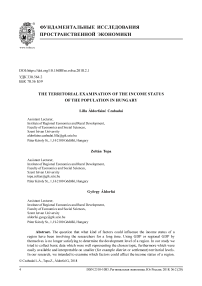The territorial examination of the income status of the population in Hungary
Автор: Czabadai Lilla Ldorfain, Topa Zoltn, Ldorfai Gyrgy
Журнал: Региональная экономика. Юг России @re-volsu
Рубрика: Фундаментальные исследования пространственной экономики
Статья в выпуске: 2 (20), 2018 года.
Бесплатный доступ
The question that what kind of factors could influence the income status of a region have been involving the researchers for a long time. Using GDP or regional GDP by themselves is no longer satisfying to determine the development level of a region. In our study we tried to collect basic data which were well representing the chosen topic, furthermore which were easily available and interpretable on smaller (for example district or settlement) territorial levels. In our research, we intended to examine which factors could affect the income status of a region. Within this framework we did our investigations in the programming period 2007-2013 because of the accessibility of data collection. We compared the sum of different subsidies, local taxes and the gross value added to the region’s income status. We illustrate our results on GIS maps at district level in order to show the present situation about the territorial differences in Hungary. By the help of the used methodology and the created maps we aimed to answer our preliminary hypothesis. According to them the received supports, the taxes paid by local people and the gross value added generated by local enterprises are showing a strong correlation with the formation of the Hungarian populations’ income status.
Income, gross value added, development, methodology, indicator, territorial differences, competitiveness, district
Короткий адрес: https://sciup.org/149131248
IDR: 149131248 | DOI: 10.15688/re.volsu.2018.2.1
Список литературы The territorial examination of the income status of the population in Hungary
- Annoni P., Kozovska K. EU Regional Competitiveness Index 2010, European Commission Joint Research Centre. Luxembourg, Office of the European Union Publ., 2010, pp. 28-47.
- Castells M. La question urbaine, Transleted by Alan Sheridan in 1977. London, Edward Amold Ltd. Publ., 1972. 493 p.
- Csath M. A regionális fejlettség mérése társadalmigazdasági mutatók alapján. Pest megyei esettanulmány . Csath M. (szerk.). Regionális versenyképességi tanulmányok . Budapest, NKE Szolgáltató Nonprofit Kft. , 2016, pp. 73-107.
- Enyedi Gy. Az urbanizációs ciklus és a magyar településhálózat átalakulása, Értekezések-emlékezések . Budapest, Akadémiai Kiadó , 1984, pp. 14-19.
- Enyedi Gy. Városi világ . Budapest, Akadémiai Kiadó , 2012. 186 p.
- GeoX Térinformatikai Kft. . Budapest, GeoIndex -Settlements purchasing power database, 2017. URL: http://www.geoindex.hu/wp-content/uploads/100x100-vasarloerotelepulesek-2017.png.
- Howard E. Garden cities of To-morrow. London, Swan Sonnenschein & Co. Ltd. Publ., 1902. 195 p.
- Huzsvai L., Vincze Sz. SPSS-könyv . Budapest, Seneca Books Kiadó , 2012. 154 p.
- Káposzta J., et al. Efficiency of Hungarian regions in using the development funds for touristic purposes. Regional Economy. South of Russia, 2014, no. 4 (6), pp. 33-39.
- Káposzta J., Nagy H. Gross Domestic Product as an indicator of regions’ competitiveness for plant-soil interrelations. Cereal Research Communications, 2008, vol. 36. 5. Supplement, Budapest, Akadémiai Kiadó, 2008, pp. 2039-2042.
- Káposzta J., Nagy H. Status Report about the Progess of the Visegrad Countries in Relation to Europe 2020 Targets. European Spatial Research and Policy, 2015, vol. 22, no. 1, pp. 81-99 DOI: 10.1515/esrp-2015-0018
- Le Corbusier. Towards a New Architecture (Vers une Architecture), Translated from the thirteenth edition and with an Introduction by Frederick Etchells. New York, Dover Publications Inc. Publ., 1986. 318 p.
- Péli L., Neszmélyi Gy. Territorial Differences of Rural Cities and the Development of Transport Infrastructure in Hungary. Romanian Review of Regional Studies: Journal of the Centre for Regional Geography, 2015, no. 11 (2), pp. 69-84.
- Porter M., et al. Social Progress Index 2015. Washington, Social Progress Imperative Publ., 2015. 158 p.
- Sajtos L., Mitev A. SPSS kutatási és adatelemzési kézikönyv . Budapest, Alinea Kiadó , 2007, pp. 203-214.
- Sassen S. The Global City. New York, London, Toky, Princeton University Press Publ., 1991, pp. 22-34.
- Schuchmann J., Váradi Zs. A magyar nagyvárostérségek társadalmi-demográfiai szerkezete . Szirmai Viktória (szerk.). A területi egyenlőtlenségektől a társadalmi jól-lét felé . Székesfehérvár, Kodolányi János Főiskola , 2015, pp. 111-130.
- Stern S., et al. Social Progress Index 2016. Washington, Social Progress Imperative Publ., 2016. 41 p.
- Stiglitz, et al. Mismeasuring Our Lives: Why GDP Doesn’t Add Up. e-report. Report by the Commission on the measurement of Economic Performance and Social Progress Publ., 2010. URL: http://library.bsl.org.au/jspui/bitstream/1/1267/1/Measurement_of_economic_performance_and_social_progress.pdf
- Szirmai V., ed.Urban Sprawl in Europe: Similarities or Differences? Budapest, Aula Publ., 2011. 280 p.
- Tóth R. magyarországi kis-és közepes vállalkozások regionális különbségei in: Csath M. (szerk.): Regionális versenyképességi tanulmányok . Budapest, NKE Szolgáltató Nonprofit Kft. , 2016, pp. 143-179.
- Which regions are affected? European Comission. Regional Policy -Inforegio 2015. URL: http://ec.europa.eu/regional_policy/archive/policy/region/index_en.htm.


